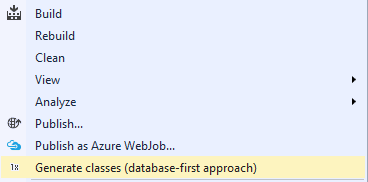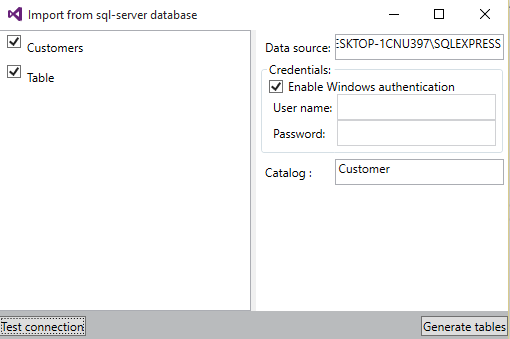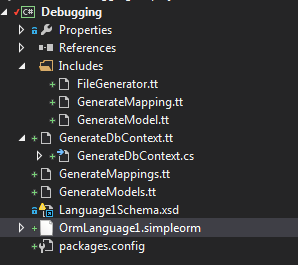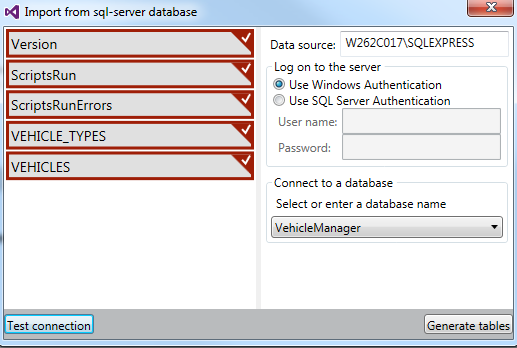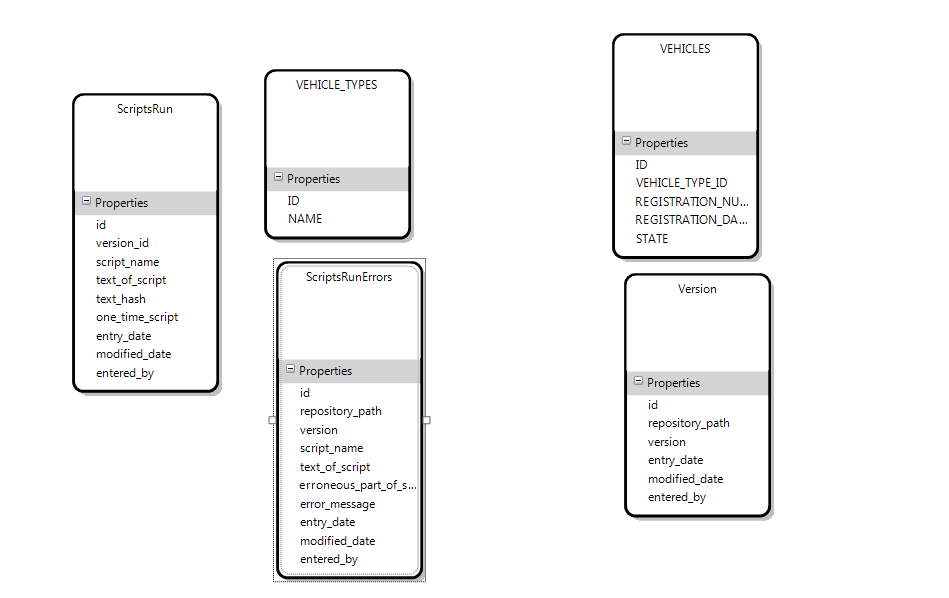Simple ORM
Build status on AppVeyor
This small ORM has a limited set of features :
- It supports some basic SQL actions such as "select", "where" & "insert" instructions. Behind the scene, the expression tree is parsed and converted into T-SQL script.
- It also allows a project to use the code first-approach.
- Two visual studio extensions are available to generate the entities from a database (model-first-approach)
Code-First approach
Some snippet-code examples :
Select request
The custom select linq-to-sql instruction :
var result = context.Customers
.Select(c => new
{
c.FirstName,
c.Id
});
The generated sql script :
SELECT ID,FIRST_NAME FROM dbo.Customers
Where request
The custom where linq-to-sql instruction :
var result = context.Customers.Where(c => c.FirstName == "Thierry");
The generated sql script :
SELECT * FROM dbo.Customers WHERE FIRST_NAME = 'Thierry'
Insert request
The custom insert linq-to-sql instruction :
using (var context = new CustomDbContext())
{
var firstRecord = new Customer
{
Id = Guid.NewGuid(),
FirstName = "temp 3",
LastName = "temp 3"
};
var sql = context.Customers.Add(firstRecord);
context.SaveChanges();
}
The generated sql script :
INSERT INTO dbo.Customers('67C6B660-1463-4065-96D5-F1C1D966B6F8', 'temp 3', 'temp 3')
Model-First approach
Two VSPackages are available to help you working with the model-first approach :
- The first one is using ENVDTE to generate the entities in the selected project.
- The second one is following the same approach as EntityFramework. It defines a Domain Specific Language (DSL) to represent entities in a schema. And it uses T4 templates to generate the classes (mappings, entities & DBContext).
First VSPackage : Generate entities with ENVDTE
Pre-requisites to use the SimpleOrm Visual studio extension:
- Visual Studio version 2013 & 2015 are supported
- The extension can work only on c# project (WPF or ASP.NET MVC)
- Add this feed (http://vsixgallery.com/feed/extension/8fb8f658-e088-4b06-bd4a-87d34fbf8c80) to Visual Studio's extension manager from tools : Tools -> Options -> Environment -> Extension and updates.
A VSPackage is available at this URL. It enables a developer to connect to a SQL-Server database, select the tables and generate the entities in the selected project. Follow those steps, if you want to use the extension :
- In the Visual Studio Extension Gallery (the one you've added) download the "SimpleOrm" VSIX package and install it.
- Once the extension is installed, open a .NET solution (ASP.NET MVC or WPF) and select a c# project.
- Right click on the "c# project" and click on the item "Generate classes (database-first approach")
- A new window is displayed
- Specify the information to connect to your database. Check if your connection information are correct by clicking on the button "test connection", if the connection success then a list of tables is displayed.
- Choose the tables for which you want to generate an entity and click on "Generate tables". Once you've confirmed the generation, all the assets are generated (entities, mappings, DBContext) and added to the selected project, the connection string is added to the configuration file (either APP.CONFIG or WEB.CONFIG) and the Nuget package "SimpleOrm" which coming from the Nuget feed is installed. The following screenshot shows the result of the transformation :
Second VSPackage : Domain Specific Language
Pre-requisites to use this VSPackage :
- Visual Studio version 2013 & 2015 are supported.
- The extension can work only on C# project.
Based on the version of your Visual Studio, download the correct "VSPackage" from the GIT artifacts (available since the release 0.0.0.11). Once the VSPackage is installed, start a new Visual Studio instance and create a new console application (C#). Follow those steps :
- In the new project, add a new item "OrmLanguage.simpleorm".
- Several files will be added into your project : ** File with ".simpleorm" extension : visual representation of your entities. ** GenerateDbContext.tt : is used to generate the DBContext file. ** GenerateMappings.tt : is used to generate all the mappings. ** GenerateModels.tt : is used to generate all the entities.
- Edit the "OrmLanguage.simpleorm" file. An empty pane window is displayed. On the left of the screen, there're two new objects under "OrmLanguage" (Entitiy & EntityRelationShip). You can drag & drop them into the model viewer.
- Right click on the "model viewer" and click on "Generate entities", a new window will be displayed. Follow the steps describe in the previous "VSPackage" above and click on generate.
- New entities have been added into the model-viewer. Then you can use the T4 templates to generate the files (mappings & entities & DBContext)
Release process
Each time a label is pushed on the "master" branch to the remote repository, the following actions happened :
- A new release is created on GITHUB with the artifacts (VSIX package, Library.zip & Nuget package)
- The nuget package is published.
- The VSIX packages are manually deployed to the Gallery & they are available in the GIT artifacts.

